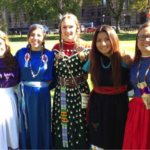by Katie McCleary
feature photo courtesy of Alex Zhang
Yale University
Indigenous Peoples’ Day at Yale University received an unprecedented amount of local press not because Indigenous peoples spent two days radically resisting settler colonialism by celebrating each other and their ancestors’ resistance, but rather because of the controversy surrounding the circulation of racist imagery.
On Saturday, October 8, the Peer Liaisons of the Native American Cultural Center organized a trip to watch the Yale-Dartmouth football game. We happily spent our Saturday cheering on Indigenous first years in the Yale Precision Marching Band and the Yale Football team. Later that day we discovered that the Yale-Dartmouth 100th anniversary game program featured racist images of Native peoples.
Despite being the proportionately most involved community on campus, Native students’ well being is carelessly ignored. Last fall’s discussions and pushes for recognition on campus have resulted in racist imagery and continued erasure of Indigenous peoples. The Yale-Dartmouth football program isn’t an isolated incident. The program isn’t a mistake made by one person. The Yale-Dartmouth football program is just one way that Yale University lacks an understanding of Indigenous peoples.
Yale refuses to recognize the continued relationship the Quinnipiac people have with the land on which the University resides. The Yale Peabody Museum of Natural History displays racist imagery of Connecticut Native peoples and keeps items on view that prevent some Indigenous peoples’ from even visiting the Museum. Both the Yale University Art Gallery and Yale Peabody display solely historical art in their permanent exhibits, erasing contemporary Indigenous communities and peoples. Yale College employs one Native American professor and offers only a few Indigenous studies classes. Yale University fundamentally fails to understand the effects of Indigenous erasure and doesn’t respect the humanity of our ancestors or us, Indigenous peoples not of the past but of the present.
On October 10, the Association of Native Americans at Yale (ANAAY) asked the University to recognize the second Monday in October as Indigenous Peoples’ Day (IPD). Such a step would combat Indigenous erasure, help prevent further instances of racism on campus, and signify a greater commitment to fostering inclusive learning environments for Indigenous students. It is of the utmost importance that Indigenous children learn to celebrate their cultures and peoples’ continuing resilience against settler colonialism.
American Museum of Natural History in New York City

Similar to the Yale Peabody, the American Museum of Natural History displays Indigenous peoples from around the world alongside birds and fossils. On Indigenous Peoples’ Day, October 10, a movement called Decolonize this Place organized an Anti-Columbus Day tour of the American Museum of Natural History (AMNH) in New York City. Decolonize this Place handed out pamphlets to 200 attendees of the tour saying “Respect the Ancestors, Remove the Statue, Rename the day.” The movement calls for AMNH to honor the displaced and murdered Indigenous peoples sacrificed in the creation of AMNH, remove the statue of Theodore Roosevelt in front of AMNH, and urges New York City to rename Columbus day.
The statue of Theodore Roosevelt in front of AMNH shows Roosevelt astride a horse while an Indigenous (unidentified Native nation) man from the Plains and an African-American slave stand subserviently behind him. As the statute demonstrates, Roosevelt believed that whites were the “forward” race destined to raise the backward races through “industrial efficiency, political capacity, and domestic morality.” In 1886 he said “I don’t go so far as to think that the only good Indians are the dead Indians, but I believe nine out of every 10 are. And I shouldn’t like to inquire too closely into the case of the tenth.” At the end of the Anti-Columbus tour, the movement covered the statue of Roosevelt with a large tarp and continued to chant “Respect, Remove, Rename.”
Standing Rock in North Dakota

At Standing Rock militarized riot police surrounded and arrested water protectors on Indigenous Peoples’ Day. The night of the presidential debate, the US Court of appeals rejected the Standing Rock Sioux Tribe’s request for an injunction to stop the completion of the Dakota Access Pipeline after Energy Transfer destroyed sacred sites identified by Lakota. The Court ruled that surveys conducted by non-Native peoples that didn’t identify sacred sites were adequate and denied the right of water protectors to prevent sacred sites from being destroyed. At least 29 people were arrested while blocking the resumed construction at various worksites, including the well known ally Shailene Woodley.
First Official Indigenous Peoples’ Days

Across Turtle Island*, cities, schools, and organizations are taking steps to recognize Indigenous Peoples’ Day. The following cities, towns, and universities celebrated their first official Indigenous Peoples’ Days in 2016:
Asheville, North Carolina
Amherst, Massachusetts
Bainbridge Island, Washington
Boulder, Colorado
Brown University
Cambridge, Massachusetts
Denver, Colorado
Durango, Colorado
East Lansing, Michigan
Eugene, Oregon
Harpers Ferry, West Virginia
Northampton, Massachusetts
Phoenix, Arizona
Santa Fe, New Mexico
University of Utah
Yakima, Washington
Joining Minneapolis, Albuquerque, Alaska, and Minnesota State University, among others.
*Iroquois and Ojibwa concept that North America formed on a turtle’s back and has been adapted more broadly by Indigenous peoples to refer to the Western Hemisphere.
“Indigenous Beats” is a new column dedicated to the circulation and discussion of indigenous news cuz #NativeErasure. Raised on the Crow Rez in Montana I come from Apsáalooke and Chippewa-Cree families. Check back for that aunty quality gossip, reviews of indigenous arts, and coverage of issues that affect indigenous communities. I’ll be there for you when mainstream media isn’t.



